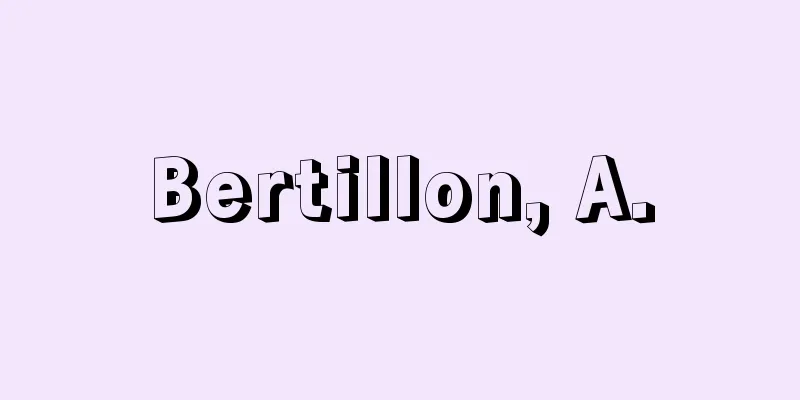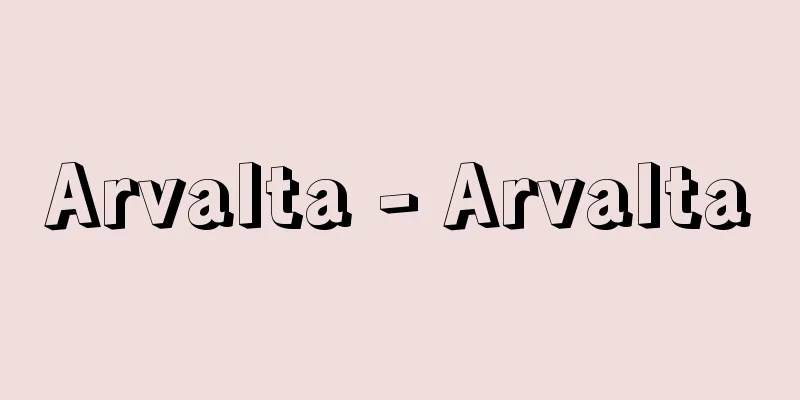Sierra Leone - Shierareone (English spelling)

|
A country in southwestern West Africa, facing the Atlantic Ocean. Its official name is the Republic of Sierra Leone. It borders Guinea to the north and east, and Liberia to the southeast. It has an area of 71,740 square kilometers and a population of about 6 million (estimated in 2011). The capital is Freetown. [Hiromitsu Nakamura and Takehiko Ochiai] NatureThe country is roughly a square, measuring 338 km north to south and 304 km east to west, and is divided into a coastal plain along the Atlantic Ocean and an inland eastern plateau. The Atlantic coast is covered with mangrove swamps and savanna plains, and many navigable rivers, such as the Lokel River and the Sewa River, run through it. The Sierra Leone Peninsula (Sierra Leone means "Lion Mountains"), from which the country takes its name, extends 40 km into the west and stretches out towards the Atlantic Ocean. The Loma Mountains and Tingi Hills are located on the eastern plateau. The country has a distinct rainy season (May to October) and a dry season (November to April), with the most rainfall occurring in July to September. The average annual temperature is 26.5°C (on the coast), and the average annual rainfall is 3,434 mm nationwide and 3,495 mm in Freetown, making it a hot and humid region. [Hiromitsu Nakamura and Takehiko Ochiai] historyIt is believed that many people migrated from the inland savannah region to the area that is now Sierra Leone in the 13th century. Contact with Europeans began in 1462 when Portuguese explorer Pedro da Cintra arrived in the area. From the 16th to the 19th century, slave trade, mainly by British people, was active. From the end of the 18th century, anti-slavery movements became more active in Britain and France, and with the support of British movement leader Granville Sharp and others, a settlement for freed slaves was built on the Sierra Leone Peninsula in 1787. The settlement, named Granville Town, was later destroyed by an attack by a local chief, but was rebuilt in 1792 by former American slaves (Nova Scotians) who had migrated from Nova Scotia (now eastern Canada), and came to be called Freetown. In addition, ex-slaves called "Maroons" who escaped from plantations in Jamaica also settled there. Sierra Leone, centered around Freetown, became a British Crown Colony in 1808 after the Sierra Leone Company, which had been managing the area, went bankrupt. The year before, the British Parliament had passed the Slave Trade Abolition Act, and Sierra Leone became a slave trade monitoring base for the British Navy, and slaves rescued from slave ships at sea were freed in Sierra Leone and began to settle there. The territory of the British Crown Colony was limited to the current Western Province region, including Freetown, and the surrounding islands, but in 1896 the British government declared the interior a protectorate, and the territory of today's Sierra Leone was almost completely determined. The spread of education and the propagation of Christianity were promoted in the Crown Colony, and the descendants of freed slaves, known as "Creoles," worked as merchants, government officials, office workers, teachers, and pastors. Samuel Ajayi Crowther, who became the first black Anglican bishop in 1842, was also a Creole from the Yoruba tribe (Creole is now called "Krio"). In the Temne region in the northern interior, which was a protectorate, a rebellion by local residents led by Temne chief Bai Bureh and others broke out in 1898 over the introduction of a hut tax on local residents' houses, but it was later suppressed by force. The protectorate adopted an indirect rule system that made full use of the power of the local chief, the paramount chief (traditional leader). Nationalism arose during the interwar period, when HC Bankole-Bright, a Creole doctor, became the leader of the Sierra Leone branch of the National Congress of British West Africa (NCBWA) and was elected to the Legislative Council. ITA Wallace-Johnson also actively led the youth movement, but was detained by the government and had his activities restricted with the start of World War II. After attending the 5th Pan-African Congress held in Manchester, England in October 1945, he organized the West African National Secretariat (WANS) as an organization to coordinate and promote nationalism in West Africa, but it disappeared after a short time. In 1946, Milton Augustus Margai, a doctor of Mende origin, and his half-brother, Albert Michael Margai, a lawyer, organized the Sierra Leone Organisation Society (SOS), which advanced nationalism in the protectorate. In 1950, the Sierra Leone People's Party (SLPP) was formed under the leadership of Milton Margai. In the general elections held in 1951, the SLPP won an overwhelming victory, and Milton Margai became Prime Minister (Chief Minister) through the amendment of the constitution in 1953. He was further promoted to Prime Minister (Premier) through the amendment of the constitution in 1956 and began preparations for independence, but his younger brother Albert Margai, who was more radical than his brother, and Siaka Probyn Stevens, a trade unionist, left the SLPP. As the struggle between the leaders intensified, an independence conference was held in London in April and May 1960, and it was decided that Sierra Leone would be independent on April 27, 1961. However, Stevens, a Limba, demanded that a general election be held before independence, and organized the Movement for Electoral Progress (EBIM). Furthermore, in September 1960, he formed the All People's Congress (APC) in opposition to Milton Margai and others. In April 1961, as the struggle progressed, including a general strike, independence celebrations were held under martial law. In the general elections held in May 1962 after independence, the SLPP won 28 of the 62 seats, while the opposition APC won 16. Milton Margai continued to form an SLPP cabinet, and when he died in April 1964, his brother Albert Margai became prime minister. In the general elections held in February 1967, the APC won by a narrow margin, but Brigadier General David Lamsana staged a coup, and a military government under the control of the National Reform Council (NRC) was established. The following April 1968, a coup ("Soldiers' Mutiny") was carried out by Stevens with the intention of restoring civilian rule, and Stevens became prime minister, forming an APC-SLPP coalition government. In March 1971, a plot to assassinate Prime Minister Stevens was discovered, and the ringleader, Brigadier General John Bangura, was arrested. In April, a transitional constitution that expanded executive power was passed by parliament, and Stevens became president of the republic. In the general elections of May 1973, the SLPP boycotted the elections, so the APC won 99 of the 100 seats in parliament. The APC also won a landslide victory in the general elections of May 1977, which were held under martial law. In May 1978, the constitution was amended, and the country transitioned to a one-party state with the APC as the only legal political party. In August 1985, President Stevens appointed Major General Joseph Saidu Momoh, also a Limba, as his successor, and Momoh, who received 99% of the votes of confidence in the October election, became president in January 1986. The Momoh administration failed in its economic policies, including curbing inflation. In April 1987, First Vice President Francis Misheck Minah and others were arrested on charges of treason, and were executed in October 1989. After that, calls for democratization, particularly a move to a multi-party system, rapidly grew, and in November 1990 the National Constitutional Revision Review Committee was established, which submitted a draft new constitution calling for the introduction of a multi-party system in March 1991. In addition to the introduction of a multi-party system, the new constitutional draft stipulated that the term of office of the president be limited to two five-year terms. The new constitution was approved by a national referendum in August 1991. In March 1991, an anti-government armed group called the Revolutionary United Front of Sierra Leone (RUF) invaded from neighboring Liberia, sparking a civil war. The RUF was originally founded by Sierra Leonean radical students who had moved their base abroad in the mid-1980s, and activists who had received military training in Benghazi, Libya, between 1987 and 1988. In the early days of its formation, the RUF was made up of only a few members and had no specific leader, but before long, former army corporal Foday Saybana Sankoh rose to prominence within the leadership and took control. First, the RUF, with the support of the National Patriotic Front of Liberia (NPFL) led by Charles McArthur Ghankay Taylor, invaded the southern and eastern parts of Sierra Leone, and began a guerilla war in both areas, which were rich in mineral resources such as diamonds. Meanwhile, a military coup took place in Freetown in April 1992, overthrew President Momoh and replaced him with Captain Valentine Strasser as head of state. The Strasser military government rapidly expanded the national army, while in 1995 it contracted with Executive Outcomes (EO), a private military company in South Africa, to train the national army and gather intelligence. Thanks to EO's activities, the war situation temporarily turned in the military government's favor, but in January 1996, the Strasser government was overthrown by a military coup and Brigadier General Julius Maada Bio became head of state. The Bio military government held the elections for a transition to civilian rule as scheduled, as Strasser had already announced, and Ahmad Tejan Kabbah of the SLPP was elected civilian president in March 1996. Shortly after assuming his presidency, Kabbah met with RUF representative Sankoh, and succeeded in signing a peace agreement in November 1996 with the mediation of Côte d'Ivoire, but the fighting did not end. In the midst of this, in May 1997, the third military coup took place since the outbreak of the conflict, toppling the Kabbah government and replacing it with a military government led by Major Johnny Paul Koroma. This coup was met with unanimous condemnation from the international community. In particular, Nigeria, a regional power in West Africa, independently intervened militarily in the country, and confronted the military government under the name of the ceasefire monitoring group (ECOMOG) deployed in Liberia by the Economic Community of West African States (ECOWAS), a regional cooperation organization encompassing West Africa at the time. In the end, in February 1998, ECOMOG, which was mainly made up of the Nigerian military, overthrew the military government, and in March, President Kabbah returned from exile, realizing the restoration of civilian rule. The situation continued to remain unpredictable, with fierce fighting erupting between the government (national army, ECOMOG, etc.) and the rebels (RUF, remnants of the Koroma military regime, etc.) over the offensive and defense of Freetown in January 1999, and the RUF temporarily detaining approximately 500 peacekeeping troops from the United Nations Mission in Sierra Leone (UNAMSIL), which had been reinforced to replace ECOMOG's withdrawal. However, from May 2001 onwards, disarmament of combatants progressed relatively smoothly under UNAMSIL, and in January 2002, the complete end of the fighting was officially declared under the cover of the president. In the presidential election held in May 2002 after the end of the conflict, the SLPP's Kaba won a landslide victory with 70% of the votes, and in the parliamentary election held the same day, the SLPP won 83 of the 112 seats. In 2002, the Truth and Reconciliation Commission (TRC) and the Special Tribunal for Sierra Leone (SLSC) were established to investigate crimes against humanity committed during the conflict. In the 2007 presidential election, the APC's presidential candidate, Ernest Bai Koroma, a Temne ethnic group, won, and in the parliamentary election the APC also won 59 of the 112 seats, becoming the leading party. In addition, the SLPP won 43 seats, and the new People's Movement for Democratic Change (PMDC) party led by Charles Margai won 10 seats. [Hiromitsu Nakamura and Takehiko Ochiai] PoliticsThe National Assembly is a unicameral body with 124 members, including 112 elected members and 12 paramount chiefs. The elected members are chosen by direct election based on single-seat constituencies, while the paramount chiefs are elected by mutual vote of the chiefs (supreme leaders) of each of the 12 districts. The president is elected by direct vote of the electorate and must receive at least 55% of the total votes. If he or she does not achieve this percentage, the president will be decided by a runoff vote between the top two candidates. The president's term of office is five years, limited to two terms. The president appoints and chairs the cabinet. Upon independence, it became a member of the British Commonwealth of Nations, and has remained in the Commonwealth even after transitioning to a republic in 1971. In 1971, it established diplomatic relations with China and North Korea, and in 1973 concluded a military agreement with neighboring Guinea. In October of the same year, it also formed the Mano River Union (MRU) to expand trade with Liberia and promote regional development cooperation (Guinea joined in 1980, and Côte d'Ivoire in 2008). It is also a member of ECOWAS, which was established in May 1975, and the African Union (AU), which was established in July 2002 as the successor to the Organization of African Unity (OAU). [Hiromitsu Nakamura and Takehiko Ochiai] Economy and IndustryThe country's per capita gross domestic product (GDP) was $467 in 1982, but fell to $184 in 1990, the year before the outbreak of conflict, and to $152 in 2000, during the conflict. However, after 2000, the country's economic situation began to improve thanks to assistance from the international community, and the GDP growth rate remained at a relatively high level, at 7.3% in 2005, 7.4% in 2006, and 6.5% in 2007. As a result, per capita GDP recovered to $325 in 2010 (IMF estimate). However, it is still at a low level compared to other African countries. Approximately 60% of the population is engaged in agriculture, and about three-quarters of the farmers cultivate food crops such as rice, but self-sufficiency is not achieved, and food imports account for more than 30% of total imports. Export crops include coffee, cocoa, and palm (palm oil). Mining is the main source of export income, with rutile (the raw material ore of titanium), diamonds, bauxite, and iron ore being the main exports. Legal diamond exports fell from 2 million carats in 1970 to 200,000 carats in the early 1990s. After the conflict, legal diamond exports amounted to $127 million in 2004 and $153 million in 2008. Rutile was first mined at the Cherbo mine in 1967. Sierra Leone is the second largest producer of rutile in the world after Australia, and rutile exports account for more than half of the country's total exports. Since 2010, the iron ore mine, Malampa, has been redeveloped by African Minerals. Industrialization once took place mainly in the Wellington Industrial Estate, located east of Freetown, with the aim of import substitution for tobacco, beer, soft drinks, etc. However, since the late 1970s, production has stagnated due to a shortage of foreign currency, a water supply shortage, and rising prices of imported raw materials, and as of 2011, production is limited to palm refining, furniture manufacturing, etc. [Hiromitsu Nakamura and Takehiko Ochiai] Society and CultureThe country is made up of many ethnic groups, but the two most dominant are the Temne (north) and the Mende (south). The Krio, descendants of freed slaves, live in large numbers around Freetown, and their language, Krio, is the common language throughout the country. As for religion, the majority are Muslim, mainly in the north, but there are also many Christians in Freetown and the south. Due in part to the effects of the conflicts of the 1990s, the estimated literacy rate for adults aged 15 and over from 2000 to 2006 was extremely low, at 47% for men and 24% for women. Fourah Bay College, the oldest institution of higher education in West Africa, was established in 1827 by the Church of England Missionary Society (CMS) as a training institution for clergy. After independence, Fourah Bay College was merged with Jala University College to form the University of Sierra Leone in 1967. In 2005, the University of Sierra Leone and Jala College were reorganized as separate, independent universities under the University Act, with the former consisting of three colleges: Fourah Bay College, the Institute of Public Administration and Management (IPAM), and the College of Medicine and Applied Health Sciences (COMAHS). Daily newspapers include Awareness Times, Awoko, Exclusive, For The People, Standard Times and Daily Mail. There is a state-run television and radio station (SLBC) as well as a private FM radio station. [Hiromitsu Nakamura and Takehiko Ochiai] Relations with JapanJapan recognized Sierra Leone at the same time as its independence in 1961. Japan does not have an embassy in Sierra Leone, but the Embassy in Ghana serves as the Japanese Embassy, and there is an Honorary Consul General appointed by the Japanese government in Freetown. The Embassy in China serves as the Japanese Embassy in Sierra Leone. In terms of trade, exports to Japan in 2009 were 402.56 million yen, and imports were 2.195 billion yen. The main exports to Japan were non-metallic mineral products, and the main imports were automobiles. There are no Japanese companies that have made direct investments in Sierra Leone. A private fisheries agreement was signed between the two countries in July 1991. In terms of aid, the Japan International Cooperation Agency (JICA) opened a field office in Freetown in 2005. Since then, technical cooperation projects have been implemented in Kambia and Port Loko districts in the Northern Region, including agriculture, local government capacity building, and health. In addition, grant aid was provided for the emergency improvement of electricity supply in Freetown and for the development of water supply in Kambia District. [Takehiko Ochiai] [References] |Organization | | | | | | [Additional information] |"> Flag of Sierra Leone ©Shogakukan Illustration/Shogakukan Creative "> Sierra Leone Location Map Source: Shogakukan Encyclopedia Nipponica About Encyclopedia Nipponica Information | Legend |
|
西アフリカ南西部、大西洋に面する国。正称はシエラレオネ共和国Republic of Sierra Leone。北と東はギニアと、南東はリベリアと国境を接している。面積7万1740平方キロメートル、人口約600万(2011年推計)。首都はフリータウン。 [中村弘光・落合雄彦] 自然国土は南北338キロメートル、東西304キロメートルのほぼ正方形に近い形で、地形は大西洋岸の海岸平野と内陸の東部高原に二分される。大西洋岸はマングローブ湿地帯やサバンナ平原が広がりロケル川、セワ川など航行可能な多くの河川が貫流する。西端に大西洋に向かって、国名の由来となったシエラレオネ半島(シエラレオネとは「ライオン山地」の意)が40キロメートルにわたって突き出ている。東部高原にはロマ山地、ティンギ丘陵がある。気候は雨期(5~10月)と乾期(11~4月)に明確に分かれ、とくに7~9月に降水量が多い。年平均気温は26.5℃(沿岸部)、年降水量は全国平均で3434ミリメートル、フリータウンで3495ミリメートルで、高温多湿の地である。 [中村弘光・落合雄彦] 歴史現在のシエラレオネの地域には、13世紀ごろ内陸部のサバンナ地帯から多くの人々が移住してきたと推定されている。ヨーロッパ人との接触は、1462年にポルトガル人の探検家ペドロ・ダ・シントラPedro da Cintraがこの地に渡来したことに始まる。16世紀から19世紀にかけてはイギリス人を中心とする奴隷貿易が盛んに行われた。18世紀末からイギリスやフランスで奴隷貿易・奴隷制度反対の運動が盛んになり、イギリスの同運動指導者グランビル・シャープGranville Sharpなどの支援で、1787年、解放奴隷のための入植地がシエラレオネ半島に建設された。グランビル・タウンと名づけられた同入植地は、その後、現地首長の攻撃によって破壊されたものの、1792年、アメリカの元奴隷でノバ・スコシア(現在のカナダ東部)から移住してきたアフリカ系人(ノバ・スコシアン)によって再建され、フリータウンとよばれるようになった。さらに、ジャマイカのプランテーションから逃亡した「マルーン」と呼称される元奴隷も入植した。フリータウンを中心とするシエラレオネは、その管理にあたってきたシエラレオネ会社の経営が破綻(はたん)し、1808年にイギリスの直轄植民地へと移行した。その前年イギリス議会は奴隷貿易廃止法を成立させていたので、以後シエラレオネはイギリス海軍の奴隷貿易監視基地となり、洋上で奴隷船から保護された奴隷がシエラレオネで解放され、定住するようになった。イギリス直轄植民地の領域はフリータウンを含む現在の西部州地域とその周辺の島嶼(とうしょ)などに限られていたが、1896年にイギリス政府は内陸部の保護領化を宣言し、今日のシエラレオネの領域がほぼ画定した。直轄植民地では教育の普及やキリスト教の布教が進められ、「クレオール」とよばれる解放奴隷の子孫たちは、商人、官吏、事務員、教師、牧師などとして活動した。1842年に黒人最初のイギリス国教会主教になったサミエル・アジャイ・クロウサーSamuel Ajayi Crowtherもヨルバ部族出身のクレオールであった(クレオールは現在、「クリオ」とよばれている)。保護領とされた内陸部北部のテムネ人の地域では、1898年、現地住民の家屋に対して課税される小屋税の導入をめぐってテムネ人の首長バイ・ブレBai Burehなどが主導する現地住民の反乱が起こったが、のちに武力で鎮圧された。保護領では、現地首長であるパラマウント・チーフ(伝統的指導者)の権力をそのまま利用した間接統治方式がとられた。 両大戦(第一次世界大戦と第二次世界大戦)間期にナショナリズムが起こり、クレオール系の医師バンコーレ=ブライトH. C. Bankole-Brightが、イギリス領西アフリカ国民会議(NCBWA)シエラレオネ支部の指導者となって、立法審議会議員にも選出された。また、ウォレス=ジョンソンI. T. A. Wallace-Johnsonは青年運動を積極的に指導したが、第二次世界大戦の開始とともに政府に身柄を拘禁されて活動を制限された。彼は、戦後の1945年10月に、イギリスのマンチェスターで開かれた第5回パン・アフリカ会議に出席したのち、西アフリカのナショナリズムの調整・推進機関として西アフリカ国民事務局(WANS)を組織したが、これは短期間で消滅した。1946年、メンデ人出身の医師ミルトン・マルガイMilton Augustus Margaiと、その異母弟で弁護士のアルバート・マルガイAlbert Michael Margaiによって、シエラレオネ組織協会(SOS)が組織され、保護領内のナショナリズムが進展した。1950年、ミルトン・マルガイの指導のもとに、シエラレオネ人民党(SLPP)が組織された。1951年に実施された総選挙ではSLPPが圧倒的勝利をおさめ、1953年の憲法改正によってミルトン・マルガイは首相(チーフ・ミニスター)になった。さらに彼は、1956年の憲法改正で首相(プレミア)に昇格して独立の準備を進めたが、兄よりも急進的であった弟のアルバート・マルガイや労働組合出身のシアカ・スティーブンスSiaka Probyn StevensらはSLPPを離脱した。このように指導者間の闘争が激化するなか、1960年4~5月にロンドンで独立会議が開かれ、1961年4月27日にシエラレオネを独立させることが決定した。しかし、リンバ人のスティーブンスは独立前に総選挙を実施するよう要求し、独立前選挙推進運動(EBIM)を組織した。さらに1960年9月、ミルトン・マルガイらに反対して全人民会議(APC)を結成した。1961年4月、ゼネストを含む闘争が進められるなか、独立祭典が戒厳令下に実施された。 独立後の1962年5月の総選挙では、SLPPは62議席中28議席、野党のAPCは16議席を占め、ミルトン・マルガイはSLPP内閣を引き続き組織し、1964年4月に彼が死亡すると、弟のアルバート・マルガイが首相となった。1967年2月の総選挙では、APCが僅差(きんさ)で勝利したが、デイビッド・ランサナDavid Lamsana准将がクーデターを起こし、国家改革協議会(NRC)支配下の軍政が敷かれた。翌1968年4月、スティーブンスによる民政復帰を意図したクーデター(「兵士の反乱」)が発生し、スティーブンスが首相となり、APC=SLPP連合政権が成立した。1971年3月にはスティーブンス首相暗殺計画が発覚し、その首謀者とされたジョン・バングラJohn Bangura准将が逮捕された。4月には行政権を拡大する共和制移行の憲法が議会を通過し、スティーブンスが共和国大統領に就任した。1973年5月の総選挙では、SLPPが選挙をボイコットしたため、APCが100議席中99議席を占めた。戒厳令下で実施された1977年5月の総選挙もAPCが圧勝した。1978年5月には憲法を改正し、APCのみを合法政党とする一党制国家へと移行した。 1985年8月に大統領スティーブンスは、後継者として同じリンバ人のジョセフ・モモJoseph Saidu Momoh少将を指名し、10月選挙で99%の信任投票を得たモモが1986年1月に大統領に就任した。モモ政権はインフレーション抑制などの経済政策に失敗した。1987年4月には、第一副大統領フランシス・ミナFrancis Misheck Minahらが反逆罪で捕えられ、1989年10月に処刑された。 その後、民主化、とくに複数政党制への移行を求める声が急速に高まり、1990年11月には国家憲法改正検討委員会が設置され、1991年3月に複数政党制導入をうたった新憲法草案が提出された。新憲法草案では、複数政党制導入のほか、大統領の任期を5年間・2期に限定することなどが規定された。新憲法は1991年8月の国民投票によって承認された。 1991年3月、シエラレオネ革命統一戦線(RUF)という反政府武装組織が隣国リベリアから侵攻し、内戦が勃発(ぼっぱつ)した。RUFは、もともと1980年代中葉に国外に拠点を移したシエラレオネ人過激派学生らと、その後1987年から1988年にかけてリビアのベンガジで軍事訓練を受けた活動家らを中心にして創設された武装勢力であった。結成初期のRUFは、ごく少数のメンバーから構成され、特定の指導者をもたなかったが、やがて元国軍伍長(ごちょう)のフォデイ・サンコーFoday Saybana Sankohが指導部内で頭角を現し、指導権を掌握した。 RUFはまず、チャールズ・テイラーCharles McArthur Ghankay Taylor率いるリベリア国民愛国戦線(NPFL)の支援を受けながらシエラレオネの南部と東部に侵攻し、ダイヤモンドなどの鉱物資源に恵まれた両地域でゲリラ戦を展開し始めた。そうしたなか、フリータウンでは、1992年4月に軍事クーデターが発生し、モモ大統領が打倒され、かわってバレンタイン・ストラッサーValentine Strasser大尉が国家元首に就任した。ストラッサー軍事政権は、国軍兵力を急速に拡大する一方、1995年には南アフリカの民間軍事企業であるエグゼクティブ・アウトカムズ社(EO)と契約し、国軍の訓練や情報収集などの業務を委託した。EOの活動などによって、戦況は一時的に軍事政権側に有利に展開したものの、1996年1月、ストラッサー政権は軍事クーデターによって打倒され、かわってジュリアス・ビオJulius Maada Bio准将が国家元首に就任した。ビオ軍事政権は、ストラッサーがすでに表明していた民政移管のための選挙を予定どおり実施し、1996年3月にはSLPPのアフマド・テジャン・カバーAhmad Tejan Kabbahが文民大統領として選出された。カバーは大統領就任後まもなくRUFのサンコー代表と会談し、1996年11月、コートジボワールの仲介によって和平合意の調印に成功するが、結局、その後も戦闘状態は収拾されなかった。 そうしたなか、1997年5月、紛争勃発以来3度目の軍事クーデターが発生してカバー政権が崩壊し、かわってジョニー・ポール・コロマJohnny Paul Koroma少佐を首班とする軍事政権が成立した。このクーデターに対しては、国際社会からいっせいに非難の声があがった。とくに西アフリカの地域大国であるナイジェリアは独自の判断で同国に軍事介入し、西アフリカを包括する地域協力機構である西アフリカ諸国経済共同体(ECOWAS)が当時リベリアに展開していた停戦監視団(ECOMOG)の名のもとに軍事政権と対峙(たいじ)した。結局、1998年2月、ナイジェリア軍主体のECOMOGが軍事政権を打倒し、3月には大統領カバーが亡命先から帰国して、文民政権の復帰が実現した。その後も、1999年1月には、政府側(国軍、ECOMOGなど)と反政府側(RUF、コロマ軍事政権残党など)の間でフリータウンの攻防をめぐって激しい戦闘が展開されたり、2000年5月には、ECOMOGの撤退と入れ替わりに増強された国連シエラレオネ派遣団(UNAMSIL)の約500名のPKO部隊がRUF側によって身柄を一時拘束されたりするなど、予断を許さない状況が続いた。しかし、2001年5月以降は、戦闘員の武装解除がUNAMSILのもとで比較的順調に進み、2002年1月には、大統領のカバーによって戦闘状態の完全終結が正式に宣言されるに至った。 紛争終結後の2002年5月に実施された大統領選挙では、SLPPのカバーが70%の得票で圧勝し、同日実施の議会選挙でもSLPPが112議席中83議席を占めた。紛争中の人道に対する罪などを調査するため、2002年に真実和解委員会(TRC)とシエラレオネ特別裁判所(SLSC)が設置された。2007年の大統領選挙では、APCの大統領候補者でテムネ人のアーネスト・コロマErnest Bai Koromaが当選を果たし、議会選挙でもAPCが112議席中59議席を占めて第一党となった。そのほか、SLPPは43議席、チャールズ・マルガイCharles Margaiが主導する新党の民主変革人民運動(PMDC)は10議席を獲得した。 [中村弘光・落合雄彦] 政治国民議会は一院制で、選出議員112名、パラマウント・チーフ議員12名の合計124名から構成される。選出議員は小選挙区制に基づく直接選挙で選ばれるのに対して、パラマウント・チーフ議員は12の県単位でチーフ(最高首長)の互選によって選出される。大統領は、有権者による直接選挙によって選出され、総投票数の55%以上を獲得しなければならない。この得票率を達成できない場合には、上位2候補の決戦投票によって決定される。大統領の任期は5年で、2期に限定されている。大統領は内閣を任命し、その議長となる。 独立と同時にイギリス連邦の構成員となり、1971年の共和制移行後も同連邦にとどまっている。1971年に中国、北朝鮮とも国交を樹立し、1973年には隣国ギニアと軍事協定を結んだ。また同年10月、リベリアとの貿易拡大、地域開発協力を促進するために、マノ川同盟(MRU)を結成した(1980年にギニア、2008年にコートジボワールも加盟)。1975年5月に発足したECOWAS、アフリカ統一機構(OAU)の後継機関として2002年7月に創設されたアフリカ連合(AU)にも加盟している。 [中村弘光・落合雄彦] 経済・産業1人当り国内総生産(GDP)は、1982年には467ドルであったが、紛争勃発前年の1990年には184ドル、紛争中の2000年には152ドルにまで低下した。しかし、2000年以降になると、国際社会からの支援もあって経済状況は改善基調に転じ、GDP成長率は2005年に7.3%、2006年に7.4%、2007年に6.5%と比較的高水準で推移した。その結果、2010年には1人当りGDPは325ドルにまで回復した(IMF推計)。しかし、他のアフリカ諸国と比べて依然として低い水準といえる。 人口の約60%が農業に従事し、農民の約4分の3は米などの食料作物を耕作しているが、自給を達成しえず、食料輸入が輸入総額の30%以上を占めている。輸出作物としては、コーヒー、ココア、パーム(ヤシ油)などがある。鉱業は主要な輸出収入源であり、ルチル(チタンの原料鉱)、ダイヤモンド、ボーキサイト、鉄鉱石などが主要輸出品である。ダイヤモンドの合法輸出量は、1970年の200万カラットが、1990年代初めには20万カラットまで低下した。紛争後、ダイヤモンドの合法輸出額は、2004年に1億2700万ドル、2008年に1億5300万ドルとなっている。ルチルは、1967年にシェルボ鉱山ではじめて採掘された。ルチル生産国としては、シエラレオネはオーストラリアに次いで世界第2位であり、ルチル輸出額は同国の輸出総額の半分以上を占めている。 鉄鉱石は、2010年以降、アフリカン・ミネラル社によってマランパ鉱山の再開発が進められている。 工業化は、かつてフリータウンの東側にあるウェリントン工業団地を中心に進められ、タバコ、ビール、清涼飲料などの輸入代替化が図られた。しかし1970年代後半以降、外貨不足、水供給不足、輸入原材料価格の高騰などによって生産は停滞し、2011年時点では、パーム精製、家具製造などに限られている。 [中村弘光・落合雄彦] 社会・文化多くの民族によって構成されているが、テムネ(北部)とメンデ(南部)が二大有力民族である。解放奴隷の子孫であるクリオはフリータウン近辺に多く居住し、その言語であるクリオ語は全国の共通語になっている。宗教は北部を中心としてイスラム教徒が多く、フリータウンや南部にはキリスト教徒も少なくない。1990年代の紛争の影響もあって、2000~2006年の15歳以上の成人識字率(推定)は、男性47%、女性24%ときわめて低い水準にある。 1827年に西アフリカでもっとも古い高等教育機関であるフーラベイ・カレッジが、イギリス国教会宣教協会(CMS)によって、聖職者養成機関として設置された。フーラベイ・カレッジは、独立後の1967年にジャラ・ユニバーシティ・カレッジと統合されてシエラレオネ大学となった。2005年、大学法によってシエラレオネ大学とジャラ大学は別個の独立した大学に改組され、前者のシエラレオネ大学は、フーラベイ・カレッジ、行政管理学院(IPAM)、医学・応用保健科学カレッジ(COMAHS)の三つのカレッジから構成されることになった。 日刊新聞には『アウェアネス・タイムス』『アウォコ』『エクスクルーシブ』『フォー・ディ・ピープル』『スタンダード・タイムス』『デイリー・メール』などがある。国営テレビ・ラジオ局(SLBC)のほか、民間のFMラジオ局もある。 [中村弘光・落合雄彦] 日本との関係日本は、1961年(昭和36)の独立と同時にシエラレオネを承認した。日本側はシエラレオネに大使館を置いておらず、在ガーナ大使館が兼館をしているが、フリータウンには日本政府が任命した名誉総領事がいる。シエラレオネ側は、在中国大使館が兼轄している。貿易面では、2009年(平成21)の対日輸出額は4億0256万円、対日輸入額は21億9567万円であった。主要な対日輸出品目は非金属鉱物製品、対日輸入品目は自動車などであった。シエラレオネに進出して直接投資をしている日系企業はない。1991年(平成3)7月に二国間で民間漁業協定が締結されている。援助面では、2005年(平成17)に国際協力機構(JICA)のフィールド・オフィスがフリータウンに開設された。以来、北部州のカンビア県とポートロコ県で、農業、地方行政能力構築、保健などの技術協力プロジェクトが展開された。また、フリータウンで電力供給緊急改善、カンビア県で給水整備のための無償資金協力が実施された。 [落合雄彦] [参照項目] | | | | | | | [補完資料] |"> シエラレオネの国旗 ©Shogakukan 作図/小学館クリエイティブ"> シエラレオネ位置図 出典 小学館 日本大百科全書(ニッポニカ)日本大百科全書(ニッポニカ)について 情報 | 凡例 |
<<: Sealand [island] - Sealand
Recommend
Grave goods
Items placed in a tomb when a dead person is buri...
International Social Science Council
…The establishment of the IRC and ICSU reflects t...
Battistello
…In the 17th century, Naples was ruled by a Spani...
Umitosaka (sea cockscomb) - Umitosaka (English spelling) soft coral
A general term for coelenterates (Cnidarians) belo...
Ponsonby-Fane, RA
…Most of the Japanese studies scholars active fro...
Katsumoto [town] - Katsumoto
An old town in the northwest of Iki Island, Iki Di...
Haanpaa - Haanpaa (English spelling)
Finnish author. After graduating from elementary ...
Color field painting
It is translated as painting of a field of color....
Union Mondiale Democrat-Chrétienne (English) Union Mondiale Democrat-Chrétienne
In 1956, 19 Christian democratic parties in Weste...
Maritime Accident Inquiry - Kainan Simpan
Based on the Marine Accident Tribunal Act, the Mar...
Festuca rubra (English spelling) Festuca rubra
…【Hoshikawa Kiyochika】. … *Some of the terminolog...
"Enkun Gyoshoki"
...The activities of Yamabushi became more active...
Pityrogramma argentea (English spelling) Pityrogrammaargentea
…[Shigeyuki Mitsuda]. … *Some of the terminology ...
Turtle play
...People also visit the graves of their ancestor...
Digestive gland
〘noun〙 A gland attached to the digestive tract tha...


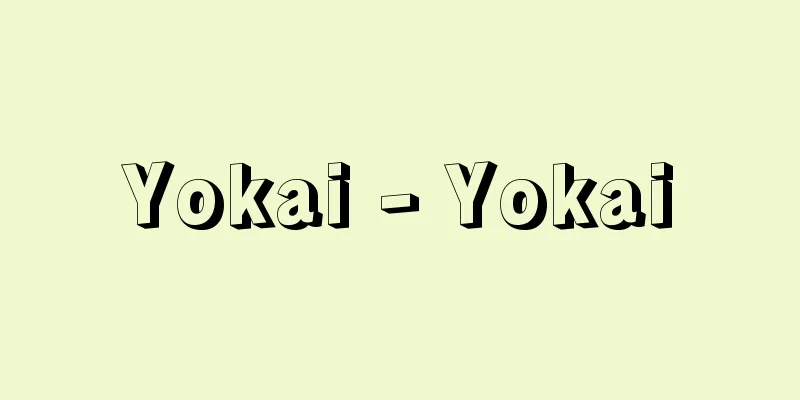

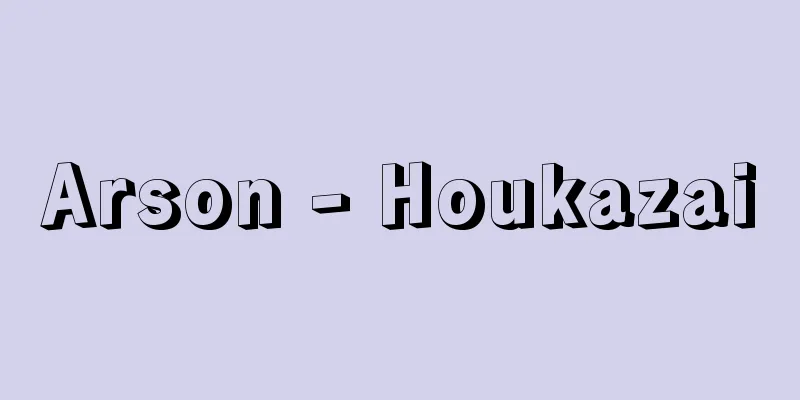
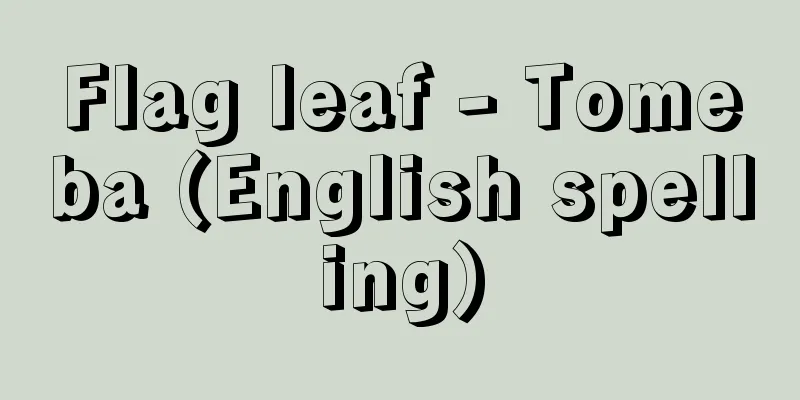
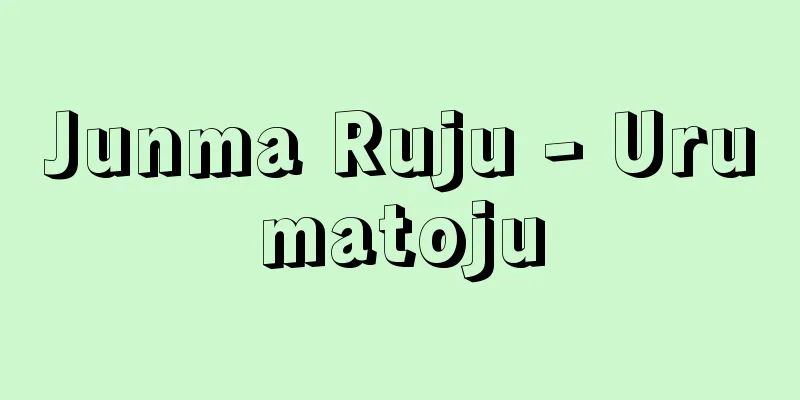
![Kushihara [village] - Kushihara](/upload/images/67cb68007dcf9.webp)
